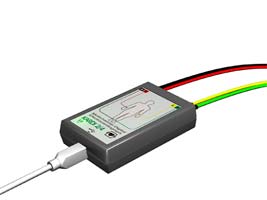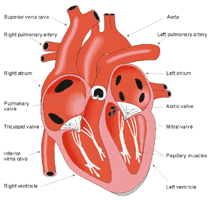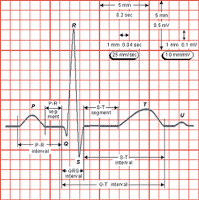|   
 
Heartview has developed an innovative heart screening system which provides physicians with a state-of-the-art method for earlier non-invasive diagnosis of heart pathologies.
The Cardiovisor 6C System is based on the analysis of the heart electric excitation processes and 3D visualization. The medical device includes software that converts the electric conductivity
of the cardiac tissue into a three-dimensional, color-coded and easy-to-interpret visual portrait. This heart portrait allows physicians to observe the condition of the heart muscle and the intensity
of the heart stress load after only 60 seconds.
Main features:
· Quantitative estimation of the heart state.
· Acquisition only standard EKG leads from hands and legs in sitting position.
· Total checkup duration is less than one minute.
· Patients database and dynamic comparison of the results.
· Provides better sensitivity and specificity for heart diagnosis. Depending on the pathology, this instrument sensitivity surpasses standard EKG analyzers by 7-50 times.
Enables earlier detection of heart abnormalities.
· Utilizes new information from EKG fluctuations usually ignored as 'a noise' by regular EKG devices.
· Evaluates the stability of the current heart state. This is extremely important since heart with major deviations can be steady (such patients often live long lives) and, on the contrary,
heart with small deviations can be extremely unstable and fall in dangerously unexpected relapse.
· Detects small metabolic deviations preceding the dangerous ischemic damages of myocardium.
· Requires much less professional skills and training for better and faster results than regular EKG diagnosis, which is "state-of- the art" for general practitioner.
CardioVisor-06c is computer cardioanalyzer and software. It is supplied complete with import ECG electrodes for limbs. Connecting with the computer is made through interface USB.
The software is intended for operation with computers with Microsoft operation system Windows-98, Windows-2000, and Windows-XP.
Description of the method of analysis used in the device
The principle of operation is based on the new method of analysis of casual low amplitude fluctuations of the ECG signal - ECG dispersion plotting. ECG DP method is based on the informative topological model of small ECG fluctuations - ECG ITM. The main algorithm
procedures of the ECG DP method is based on the following.
The multiplicity of control effects and variability of receptor signals determining electrochemical phenomena in depolarization-repolarization processes of the myocardium
inevitably leads to small casual ECG fluctuations with each contraction of the heart even in the state of physiological norm. The amplitudes of these fluctuations (dispersion of
fluctuations) according to the authors' data do not exceed 0.01…0.03 mV, i.e. they are several tens of times smaller than amplitudes of ECG peaks. The term "dispersion" corresponds
to the generally accepted definition of difference between the maximal and minimal values of the varying quantity. In order to observe and measure the characteristics of such casual fluctuations
it is necessary to plot the signals of ECG one-type peaks, i.e. synchronize the beginning of electric excitation of several successive peaks. Fig.1 and Fig.2 give examples of such low amplitude QRST
fluctuations in one of the leads. Fig. 1 shows ECG low amplitude fluctuations of a healthy person, Fig.2 - in case of sub-acute stage of MI. In the cited cases one can see some characteristic amplitude
and frequency peculiarities of changing fluctuations.

Fig1. ECG low amplitude fluctuation in successive QRSTcomplexes of a healthy heart.
a) single complex; b) 7 successive synchronized complexes

Fig. 2. ECG low amplitude fluctuation in successive QRST complexes with MI.
a) - single complex; b) 7 - successive synchronized complexes
Regularities of variation of such fluctuations due toinsignificance of the amplitude and casual nature were not studied in the generally accepted methods of ECG analysis.
With the beginning and development of myocardial pathology dispersion characteristics begin to change earlier than ECG peaks. Therefore with control of dispersion characteristics it is possible
to obtain information about developing pathology with forestalling. It is this principle that is used in CardioVisor-06c to raise sensitivity of the ECG analyzing technique under consideration to pathological
changes. The unique peculiarity of dispersion characteristics is their high specificity in differentiation of norm-pathology states, i.e. CardioVisor-06c does not detect pathology in cases where there is no
pathology.

Fig.3. Visual structure of the right. sections of the heart  Fig.4. Visual structure of the left sections of the heart. Fig.4. Visual structure of the left sections of the heart.
v - vertical axis of the heart L - longitudinal axis of the
1 - vena cava superior
2 - aorta
3 - rhythm integral indicator
4 - indicator of the state of RA myocardium (depolarization dispersion)
5 - indicator of P-Q interval anomalies
6 - indicator of stability of AB-conduction
7 - integral indicator of the state of two auricles (general characteristics conditioned by common source of excitation)
8 - indicator of final phase of RV depolarization (projection in the region of the interventricular septum)
9 - indicator of ventricular repolarization duration (correlates with Q - T)
10 - indicator of state of RV myocardium (repolarization dispersion)
11 - indicator of ventricular depolarization duration (QRS duration)
12 - indicator of state of LV myocardium (repolarization dispersion)
13 - indicator of final phase of LV depolarization
14 - indicator of state of LV myocardium (repolarization dispersion)
15 - indicator of final phase of RV depolarization (projection on posterior wall)

Fig.5. Examples of heart portraits. a) - norm, b) - IHD, PICS, diabetes mellitus.

Fig .6. Reproducibility of pathological heart portrait with stable state of myocardium.
a) - first portrait, b) - 10 minutes later c) - one day later
Effectiveness of using the device
The characteristics of CardioVisor -06c considerably excel those of analogues intended for ECG screening. Suffice it to say that the time of obtaining the conclusion is 1…3 minutes, control is made
without taking off clothes in the sitting position and indexes of sensitivity and specificity to ischemic heart disease increase to 80%.
For comparison: mean ECG-12 sensitivity to IHD is only 30…40%. The latter means that more than 60% of occult or pre-clinic forms of developing ischemic heart disease at
present are not elicited by methods of standard ECG analysis and require applying other expensive methods of investigation (CAG, myocardial scintigraphy, etc.).


Fig. 7 Diagram of applying electrodes.

Fig. 8 ECG characteristics meter
|